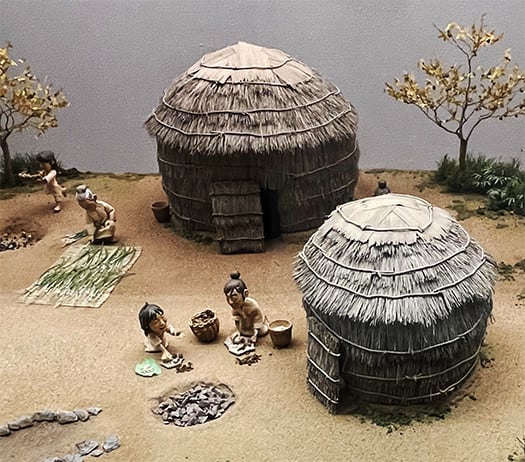



旧石器から縄文へと変遷してくると定住もあって
より安全な社会が到来したとつい考えたくなる。
実際にマルクス共産主義思想にわたしが惹かれた経験があるのも、
いわゆる「原始共産社会」というイメージ刷り込みが行われ
そこでは階級格差のない平和な社会が実現していたというプロパガンダが
盛んに流布されていたからだと思うのです。
青年期を迎えた正義心には魅力的な社会と思った部分がある。
しかし歴史を冷徹に見ていけば、狩猟の手段も縄文期に進化して
とくに「弓矢」という、後の世の戦争・殺し合いの主要ツールが
この縄文の世で育まれたことがわかってくる。
日本列島では縄文という漁撈と採集を生業とした社会が実現するけれど
世界史一般としては旧石器から農耕社会に移行していく。
縄文と同様にこの弓矢の発明、殺戮武器の進化があってレッドラインを超えていく。
農耕社会では「略奪可能な食料」としての農産物集積があり、
それを社会同士で奪い合う戦争が常態化していくことになる。
日本列島では農耕はやや遅れて弥生の世まで待つことになり
比較的に戦争の時代は遅れたのではないかと推定できるけれど、
さりとてマルクス主義の理想郷社会とは実態は乖離していたと想像できる。
図のように弓矢の発明は旧石器由来の狩猟のツール進化であることは疑いない。
大型陸上動物のハンティングによって種の減少があり
それをカバーするためにより小動物を遠距離から狙う必要性が高まった。
縄文の世を実現した落葉広葉樹の森は同時に多様な小型生物種も増加させた。
旧石器時代の追いこみ猟・落とし穴猟に加えてこういう「飛び道具」の出現。
弥生以降の血生臭い戦争は縄文の世が育んでいったことになる。
動物を殺戮可能なツールは人間に対しても当然有効。
けっしてユートピア社会だったのではなく次代の戦争の時代を着々と準備した。
縄文の世は定住が実現することで同時に地域社会が作られたと思える。
そういう地域間同士というのは必然的に近攻遠交という考え方を生む。
狩猟の「縄張り」が隣接する同士はどうしても反目する。
弥生の世になると農耕地自体が「財」として認識されて
「一所懸命」的な思想を人類に刷り込んでいくけれど、
その前段階の思考法は縄文でもあったに違いない。
境界線は弥生以降の農地のように明示的ではないけれど
やはり慣習的「猟場」感覚はそれぞれ社会で認識されていただろう。
そういう認識相互での反目関係は容易に成長しただろう。
社会が形成されれば必然的に「安全保障」を人類は求めることになる。
北海道での北方民の研究で狩猟採集段階の人々の間でも
弓矢で殺害されたことが明示的な遺骨発掘があったとも聞いている。
弓矢という「兵器」開発にはどうしても強い関心を持ってしまう。
English version⬇
The Invention of the Bow and Arrow in the Jomon Period and the Foreboding of War 37,000 Years of Japanese Archipelago - 14
Sinful humans continued to slaughter wild animals with gentle eyes. The "weapon" itself evolved and developed. ...
As the transition from Paleolithic to Jomon, there was settlement.
It is tempting to think that the transition from Paleolithic to Jomon brought about a safer society.
In fact, my experience of being attracted to the Marxist-communist ideology is due in part to the imprinting of the image of a so-called "primitive communist society" on my mind.
I was attracted to Marx's communist ideology because it imprinted an image of a so-called "primitive communist society," where there was peace without class inequality.
and the propaganda that a peaceful society with no class disparity had been realized there.
I think it was because of the propaganda that was actively disseminated.
A part of me thought it was an attractive society for the righteous minds of my youth.
However, if we take a cold look at history, the means of hunting also evolved during the Jomon period, and
In particular, the "bow and arrow," a major tool for war and killing in later times, was developed in this Jomon period.
The Jomon period was also the time when the Jomon developed the bow and arrow, the main tool for warfare and killing in later times.
In the Japanese archipelago, the Jomon realized a society that depended on fishing and gathering for its livelihood, but in the world history in general, the Jomon developed from the Paleolithic period.
In the Jomon period, the Jomon were a fishing and gathering society, but world history in general has seen a transition from Paleolithic to agricultural societies.
As with the Jomon, the invention of the bow and arrow, and the evolution of killing weapons, crossed the red line.
In an agrarian society, there is an accumulation of agricultural products as "lootable food.
Warfare in which societies fight each other for it will become the norm.
In the Japanese archipelago, agriculture was delayed until the Yayoi period.
In the Japanese archipelago, agriculture was delayed until the Yayoi period, and the age of war was probably delayed comparatively.
However, we can imagine that the reality of the society was far removed from the Marxist utopia.
As shown in the figure, there is no doubt that the invention of the bow and arrow is a tool evolution of Paleolithic origin hunting.
Hunting of large terrestrial animals led to the decline of species, and to compensate for this, there was a decline of smaller animals.
The hunting of large terrestrial animals led to a decrease in the number of species, and to compensate for this, the need to target smaller animals from a distance increased.
The deciduous broadleaf forests that made the Jomon period possible also increased the diversity of small species.
In addition to the pursuit and pitfall hunting of the Paleolithic period, these "jumpers" emerged.
The bloody wars of the Yayoi and later periods were fostered by the Jomon period.
Tools that can kill animals are naturally effective against humans.
The Jomon were not a utopian society, but were steadily preparing for the next era of warfare.
The Jomon period seems to have been a time of settlement and the creation of regional societies.
The idea of close combat between regions inevitably led to the concept of "close combat".
Adjacent hunting "territories" inevitably turned against each other.
In the Yayoi period, agricultural land itself was recognized as "property.
The Yayoi period, which was the beginning of the "hard-working" mentality that was imprinted on the human race, was a time of conflict.
The Jomon must have had a way of thinking at an earlier stage.
Although the boundaries are not as explicit as those of agricultural lands in the Yayoi period and later, the Jomon must have had their own customary "hunting grounds".
The Jomon also must have had a customary sense of "hunting grounds," although the boundaries were not as explicit as those of agricultural lands since the Yayoi period.
Such mutual antagonisms would have grown easily.
Once a society is formed, it will inevitably seek "security" for its people.
Studies of northern peoples in Hokkaido have shown that even among hunter-gatherer peoples, it is not uncommon for people to be killed by bow and arrow.
I have also heard that there have been remains excavated in Hokkaido that clearly indicate that people were killed with bows and arrows.
I cannot help but have a strong interest in the development of "weapons" called bows and arrows.



















